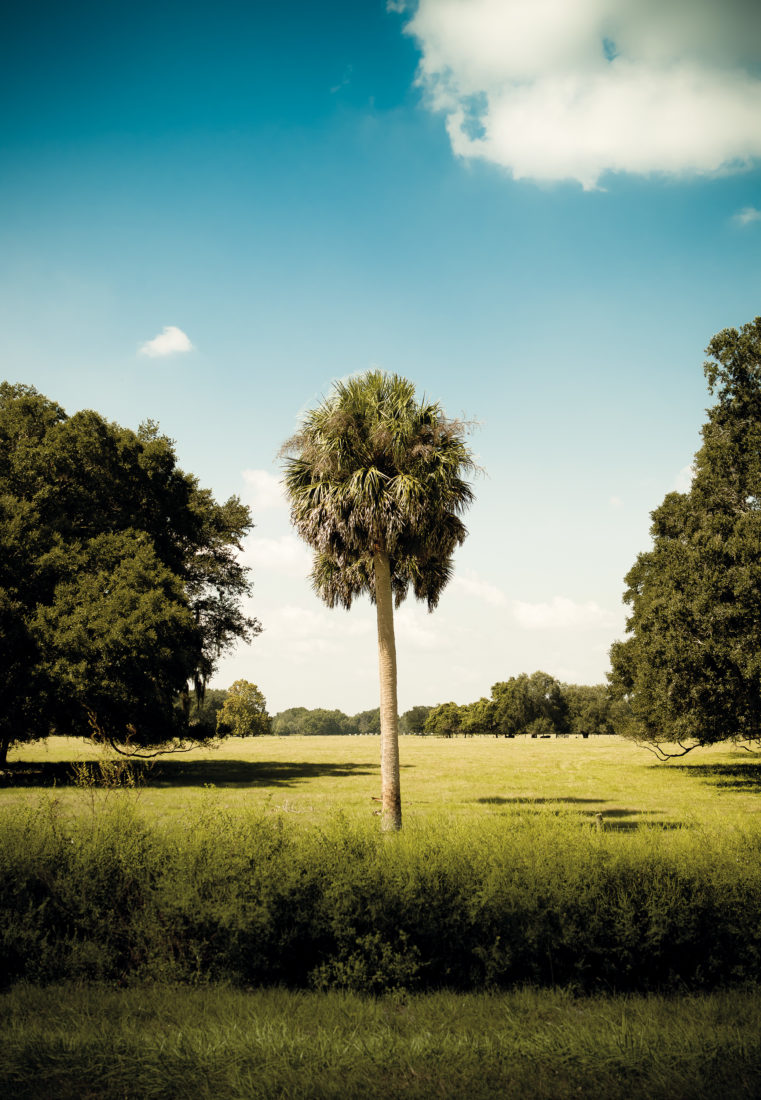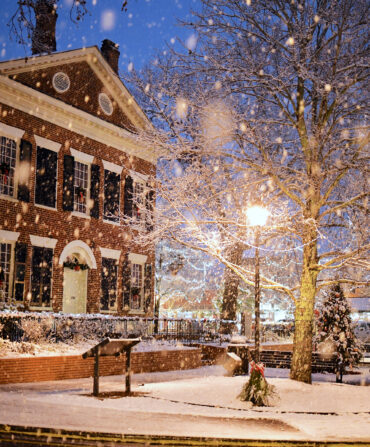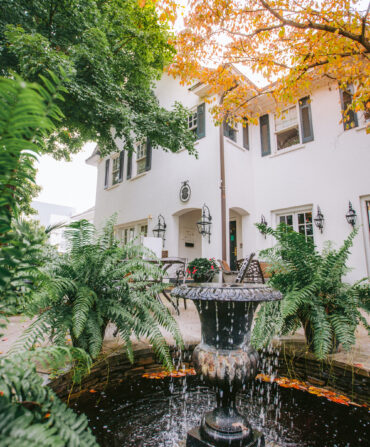BBQ
Peeble’s BBQ
Auburndale
Drive down Dixie Highway on the outskirts of Auburndale and you’ll see a dilapidated white shack with screen windows, a big woodpile out back, and smoke billowing from an indoor pit. The sight alone is enough to make any true barbecue buff’s heart beat a little faster. Go inside, taste the chopped pork and ribs, and you’ll understand why Peeble’s sits atop the heap of Florida BBQ joints. 863-967-3085
Cigar Bar
King Corona Cigars
Ybor City
A café and cigar bar, King Corona sits squarely in historic Ybor City (once the nation’s cigar capital), blending Tampa’s unique history and multiethnic flavor with the good old-fashioned social interaction of yesteryear. Lounge under the covered patio and enjoy a local, hand-rolled cigar and some conversation. Try a traditional Cuban breakfast, complete with Cuban-style coffee, or lunch on a Cuban sandwich where they originated, right here in Ybor City. After coffee and cigars, opt for a haircut and hot shave before getting on with the day. kccigarsandcafe.com
Country Drive
Canopy Roads of Leon County
Tallahassee
Along the nine designated canopy roads that spread out from Tallahassee like the spokes of a wheel, you’ll see Indian mounds, Civil War forts, antebellum houses, historic quail plantations, and Spanish ruins. But the canopy roads themselves are the show stealer. These ancient allées of grandiose, moss-bearded oaks meander through the Red Hill region, many of them paved only with red clay. They were first carved out over centuries of use by the Apalachees, then used as trading routes by the Spanish, then by planters as oxcart roads during the cotton boom. Now the roads don’t lead to much of anything, which is exactly the point. leoncountyfl.gov
Cracker Grub
Yearling Restaurant
Hawthorne
When you’re hungry for something that started out in a swamp and ended up in a deep fryer, the Yearling Restaurant is ready for you. A few miles down County Road 325 from the Cross Creek homestead where Marjorie Kinnan Rawlings typed the novel for which it’s named, this roadside Cracker landmark, which first opened in 1952, serves up frog legs, gator tail, and (if you’re lucky) cooter, aka soft-shell turtle. If breaded amphibian isn’t on your to-do list, treat yourself to venison, sour orange pie, and the music of Willie Green, a septuagenarian who has opened for John Lee Hooker and Eric Clapton and brings Delta-style blues to the knotty-pine dining room Thursday through Sunday. yearlingrestaurant.net
Country Store
Bradley’s Country Store
Tallahassee
Since 1910, four generations of Bradleys have been making sausage—mild, medium, hot, and smoked or fresh. They opened the store in 1927, twelve miles down Centerville Road from Tallahassee. Like their recipes, the store hasn’t changed over the years. Along with their liver pudding, hogshead cheese, pork cracklings, and mighty good coarse-ground grits, the Bradleys sell some of the best old-fashioned country sausage anywhere. Eat there, cook it at home, or have them ship it to you. bradleyscountrystore.com
Dive Bar
Capt. Tony’s
Key West
Through several incarnations since it was built in 1852, the building that houses Capt. Tony’s served as an icehouse, a morgue, and the telegraph station that announced the sinking of the battleship Maine, precipitating the outbreak of the Spanish-American War. There were also stints as a cigar factory, a brothel, a speakeasy, a gambling den, and finally a dive bar. It housed the original Sloppy Joe’s, where Hemingway hung out and where his third wife, Martha Gellhorn, supposedly paid the bartender $20 to introduce her to him. In 1958 a charter boat captain, Tony Terracino, who had come to Key West while on the run from New Jersey bookies after a gambling scheme went awry, bought the place and turned it into its current incarnation. It’s dark and dusty, and absolutely reeks with history. capttonyssaloon.com
Diner
Duck’s Dam Diner
Moss Bluff
A nondescript roadside diner on a back road in the outskirts of the Ocala National Forest, Duck’s Dam Diner has been serving up the finest diner eats in Florida for the past decade. It’s the sort of place where the staff gets worried when a regular doesn’t show up at the normal hour. Duck’s will serve early-rising fishermen a burger at seven a.m. or breakfast in mid-afternoon. The biscuits and gravy are the best around, so stop by for a fill-up on your way to the woods. 352-288-8332
Fishing Hole
Marquesas Keys
Key West
It requires a thirty-mile run across an often choppy Boca Grande Channel, but if a flats slam (tarpon, permit, and bonefish) is on your bucket list, the run to the Marquesas Keys is well worth it. Fly casters flock to the atoll every spring for shots at tarpon up to ninety pounds in Mooney Harbor and the surrounding flats. Permit topping forty pounds are another real possibility, and the Marquesas offer the best chance for bonefish in the lower Keys, says Captain Steven Impallomeni, whose clients have scored double fly slams by mid-afternoon. 305-292-9837
Freshwater Springs
Edward Ball Wakulla Springs State Park
Tallahassee
There’s archaeological evidence that humans have been frequenting Wakulla Springs for 15,000 years. And other than a lodge built in 1937 by Florida financier Edward Ball and a few glass-bottomed boats, not much has changed since those first visitors arrived. There’s plenty of swimming to be enjoyed in one of the world’s largest and deepest freshwater springs, and loads of wildlife along the hiking trails. floridastateparks.org
Hotel Veranda
Tampa Bay Hotel
Tampa
Now part of the University of Tampa and the Henry B. Plant Museum, the Tampa Bay Hotel veranda is one of the last of the great ones that typified Florida resort life from the 1870s through the 1930s. With the hotel serving as a base of operations for the Spanish-American War, Teddy Roosevelt, Rough Riders, and others rocked away on the veranda as they plotted strategy. In more peaceful times, the veranda hosted a cavalcade of boldface names, among them the Prince of Wales, Stephen Crane, and Sarah Bernhardt. plantmuseum.com
Horseback Riding
Ocala National Forest
Ocala
Ocala, which bills itself as “The Horse Capital of the World,” is a great place to tour Thoroughbred farms and watch equestrian events. But for a riding experience of your own, head for the Ocala National Forest. There you can hoof it over miles of trails through sandy scrub-pine forests. Ride to Juniper Springs and take a dip in the crystalline sapphire waters before setting up camp for the night. If your timing’s right, you might even sight a black bear. fs.usda.gov/ocala
Jazz Bar
The Warehouse Bar
Tallahassee
Housed in a converted warehouse on Gaines Street, the Warehouse Bar holds its Jazz Night every Monday. The house band, the Warehouse Trio, plays originals and jazz standards. But the party really gets started during the second set, when local musicians, music students, and faculty from Florida State and Florida A&M join in with whatever instruments they happen to bring along. There’s never a shortage of fresh talent taking the stage. 850-222-6188
Laid-back Lodging
Seminole Inn
Indiantown
All too rarely does one come across a hotel whose roster of diversions for guests includes “frog gigging.” That’s but one reason to check in to the Seminole Inn, a gracious and unlikely Mediterranean Revival hideout in Indiantown, thirty miles northwest of West Palm Beach in the citrus-and-cattle country near Lake Okeechobee. In the 1920s, a Baltimore banker named Solomon Davies Warfield foresaw a glorious future for the town as a railroad hub, and embellished the inn, its crown jewel, with high cypress ceilings, solid brass fixtures, and grand staircases. Warfield’s vision for Indiantown never quite blossomed. But he left behind a welcoming home base for bass fishers, hunters, and those just seeking to log some serious time in the porch swing. seminoleinn.com
Literary Field Trip
Marjorie Kinnan Rawlings House
Cross Creek
The Cracker-style cottage on the edge of the orange groves where Marjorie Kinnan Rawlings came in 1928 to farm and write still stands near the Cross Creek community. For over a quarter-century, she called this spot home, and here she wrote Cross Creek and The Yearling, her Pulitzer-winning novel. The house, still filled with Rawlings’s own furniture, has been restored to reflect that period. Go see for yourself what the author called “the essence of an ancient and secret magic.” floridastateparks.org
Old-School Inn
Gasparilla Inn
Boca Grande
Since its pre–World War I opening on its namesake seven-mile-long Gulf island, the Gasparilla Inn hasn’t changed all that much—which is precisely the idea. It remains a quiet, isolated, clubby enclave frequented by the likes of Rockefellers, Du Ponts, Bushes, and others whose names come with Roman numerals attached. During winter-and-spring Social Season, as it’s known here, dinner still calls for coats for gents. Swimming, tennis, tarpon fishing, rocking on the porch, evening canasta, and golf on the seaside Pete Dye–designed course occupy the hours. As does stealing a peek at the lobby’s clipboard to find out who’s arriving that day. the-gasparilla-inn.com
Oyster Bar
Indian Pass Raw Bar
Port St. Joe
Originally built in 1929 as a commissary for a turpentine operation, this back-road raw bar does what a raw bar is supposed to—it serves the freshest seafood in the simplest way. In the eighties, when the owners’ wholesale oyster business went bust after a hurricane blew through, they started selling off the remaining oysters out of what was then their gas station, and a raw bar was born. These days the floors are tiled orange and blue for Gator fans. Walk in and grab a beer from the cooler or fill up a pitcher before you sit down. indianpassrawbar.com
Plantation Tour
Kingsley Plantation
Jacksonville
This is not your run-of-the-mill house-museum story. Zephaniah Kingsley married and freed Anna Kingsley, an enslaved woman, in 1811. He gave her management of a plantation and freed their children, eventually moving them to Haiti to avoid the growing legal oppression of freed people of color. There Kingsley and his family built another plantation. After his death, Anna moved back to Jacksonville to take legal action against her late husband’s white relatives, who were attempting to get his will nullified. She won, living out the rest of her long life in Jacksonville. nps.gov
Private Shores
Useppa Island
Useppa
“No bridges, no cars, no crowds” is the slogan of private, residential Useppa Island, near Pine and Captiva islands on the southwest Gulf Coast, west of Fort Myers. Around the turn of the twentieth century, Useppa was the estate of New York advertising and publishing tycoon Barron Collier, who hosted such notables as Vanderbilts, Rothschilds, Thomas Edison, and Gloria Swanson. Nowadays residents, all of them members of the Useppa Island Club, get around their manicured hundred-acre enclave by boat or golf cart, making twenty-minute runs to the mainland for groceries (and virtually every other necessity) on board a regular shuttle. Unless you’re a friend or relative of a member, your best shot at sampling Useppa is to catch a two-hour stopover and lunch at the seven-suite Collier Inn on a half-day cruise from Captiva (captivacruises.com). useppa.com
Produce Stand
Robert Is Here Fruit Stand
Florida City
Robert first started selling cucumbers from his father’s roadside farm at age six with a sign that simply said “Robert is here.” Over the past fifty years his produce stand has grown to include a staggering variety of tropical fruits, vegetables, preserves, and some thirty types of honey. The produce is often locally grown, and much of it comes from Robert’s family-run farm. And if you’re in the market for a milk shake, get ready: You can have one made from any fruit on hand, from key lime to caimito. robertishere.com
Seafood Shack
Posey’s Dockside
Panacea
At Posey’s Dockside Cafe, at the end of a side road off Highway 98—best known to many as the scenic route from Tallahassee to Apalachicola—there awaits everything one could reasonably ask of a Florida seafood shack: Ice-cold beer. Outdoor tables with a pelican’s-eye view of the Panacea marina and Dickerson Bay. A no-nonsense grouper sandwich. Oysters on the half shell. And on weekends, more often than not, some guy with a guitar warbling “A Pirate Looks at 40” into a microphone. 850-713-0014
Sporting Compound
Gilchrist Club
Trenton

Photo: Terry Manier
A pair of bird dogs on the grounds of the Gilchrist Club
Sitting on 27,000 acres of diverse game habitat half an hour west of Gainesville, the Gilchrist Club offers its members a Georgia quail plantation experience deep in the heart of Florida and a world away from tourist beaches. Part club, part luxury hunting lodge, Gilchrist feels like having your own private plantation with, shall we say, a little less overhead. Quail is the staple here, but you can also hunt whitetails, wild boar, native Osceola turkey, and alligator. gilchristclub.com
Stone Crab Shack
Star Fish Company
Cortez
Stone crabs show up on any Florida foodie’s short list. And though there are many places to eat them, from one end of the state to the other, it’s hard to beat Cortez, the last remaining historic commercial fishing village on the Florida Gulf Coast. More specifically, eat a plate of them at the Star Fish Company as the sun sets over Sarasota Bay. starfishcompany.com
Swamp Tour
Okefenokee Swamp
Macclenny
Although most of the sprawling, 400,000-acre Okefenokee Wildlife Refuge lies within Georgia, Florida can still claim legitimate ties to the great blackwater bog. The refuge’s southern boundaries spill over into Florida, which contains much of the one-million-acre Greater Okefenokee Ecosystem of which the swamp is a part. In any case, a dotted line on a map matters little once you’re paddling through this wonderland of old-growth cypress stands, spongy islands, flooded prairies, and other habitat niches that shelter hundreds of species of critters, including Florida black bears and endangered red-cockaded woodpeckers. Some 120 miles of canoe trails crisscross the refuge, linking eight covered wooden-platform campsites. fws.gov/okefenokee
Swimming Hole
Venetian Pool
Coral Gables
Johnny Weismuller and Esther Williams are no longer meeting for a quick dip in the Venetian Pool in Coral Gables, but the beauty of the spot, listed on the National Register of Historic Places, remains. Created in 1923 from an abandoned quarry pit and fed by artesian wells, the pool has been beckoning to swimmers ever since. During summer, its 820,000 gallons of water drain out every evening, only to be replenished by the subterranean aquifer. Surrounded by waterfalls, porticoes, and caves, the Venetian ranks among the choicest swimming holes on the planet. coralgablesvenetianpool.com
Wild Beach
St. Joseph Peninsula State Park
Port St. Joe
Jutting north along the Panhandle like a long fishhook, St. Joseph Peninsula State Park has one of the most dazzling and least populated beaches anywhere. Snow-white dunes loom over the shore, and waves lap at nine miles of Gulf-front sand within the park’s 2,500 acres. In summer, loggerhead turtles nest on the beach, and swimmers dive for scallops in St. Joseph Bay. Come autumn, thousands of migrating hawks pass through, banking west to trace the Gulf Coast to Mexico and points beyond. The peninsula is also a sweet place to kayak, surf-cast, camp, or take a long hike through dense scrub-pine woods. Eight bayside cabins each sleep up to seven people and come with screened porches and fireplaces. Not surprisingly, they’re also notoriously tough to book. floridastateparks.org/stjoseph
Wreck Drive
Troy Spring
Branford
In the pre-railroad days of the nineteenth century, paddle-wheel steamboat traffic on the Suwannee River brought mail, provisions, and contact with the wider world to remote Florida settlements. Captain James M. Tucker was one river man who became a legend of sorts before the Civil War when he piloted his 125-foot steamer, the Madison, upstream to White Springs, almost to Georgia, greatly expanding the length of the Suwannee considered navigable. In 1863, Tucker ordered the Madison sunk in the shallow run at Troy Spring to prevent it from being captured by the Union Navy. Today, divers can inspect what is thought to be the Madison’s remaining skeleton: a ribcage of wooden timbers and metal spikes. floridastateparks.org/troyspring/
Pages








